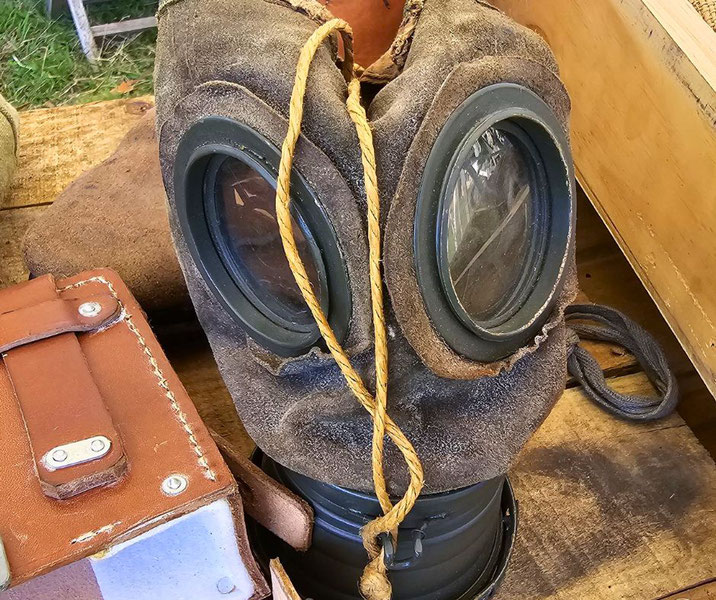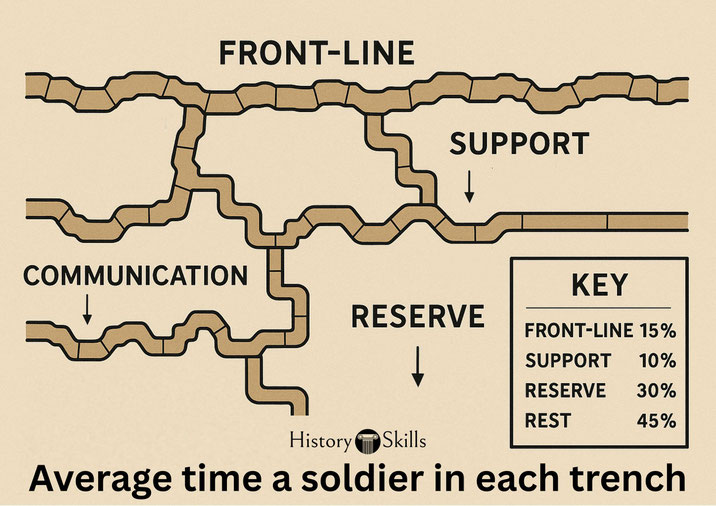How to survive in a WWI trench: 9 simple rules

One of the most enduring images of World War One is the extensive system of trenches that crisscrossed the Western Front.
These trenches, often filled with mud, rats, and the constant threat of enemy fire, were the harsh reality for millions of soldiers.
Yet, in the face of these challenges, soldiers developed a range of survival strategies that allowed them to endure these conditions.
If you ever find yourself in a similar situation, here are the things you need to know...
Just how bad were the conditions in the trenches?
Trench warfare was a type of combat in which opposing troops fight from trenches facing each other.
It emerged as a response to the rapid advancements in military technology, including machine guns and artillery.
These changes made traditional forms of warfare devastatingly lethal.
As a result, the trenches provided a form of protection from the deadly hail of bullets and shells.
However, they also introduced a new set of challenges and dangers for the soldiers who inhabited them.
The trenches themselves were surprisingly complex systems: often many miles long and consisting of multiple parallel lines.
The frontline trenches, where the soldiers lived and fought, were the closest to the fighting.
In comparison, the support and reserve trenches behind the front lines provided additional defense and areas for rest and resupply.
Finally, the space between opposing sets of trenches was known as "no man's land".
It was a deadly expanse often filled with barbed wire, shell craters, and the remains poor souls who had fallen victim to many unsuccessful attacks.
Regardless of which line of trenches the soldiers were in, the living conditions were harsh and unforgiving.
They were often waterlogged and muddy, making movement difficult. Also, rats and lice were constant companions.
They helped spread disease and added to the general discomfort of the experience.
In the face of these difficult conditions, soldiers were still expected to maintain a state of constant readiness.
They had to be prepared for the enemy's attempts to seize their trenches. This could come in the form of artillery bombardments, gas attacks, or infantry assaults.
It goes without saying that the threat of enemy fire was ever-present, and the fear of a deadly gas attack was a constant source of anxiety.
1. Wear your Brodie helmet
The Brodie helmet, one of the most iconic pieces of equipment from the war, was introduced by the British in 1915.
Made of steel and designed to protect the wearer's head and shoulders from shrapnel, the Brodie helmet quickly became a standard issue for soldiers in the trenches.
Its design was so effective that it influenced military helmet design for many decades after the war.
2. Don't forget a gas mask
Gas masks were considered to be an essential piece of protective equipment. The use of chemical weapons, particularly chlorine and mustard gas, was a horrifying aspect of World War I.
Unfortunately, early gas masks were often quite rudimentary: consisting of a cloth soaked in a solution designed to neutralize the gas.
However, as the war progressed, more sophisticated designs were introduced.
They included masks with filter canisters that could protect against a variety of chemical agents.

3. Stay warm and dry
Protective clothing and footwear were also vital for survival. Soldiers were issued with heavy woolen uniforms designed to provide some protection from the elements.
However, the damp and muddy conditions in the trenches often meant that these uniforms inadequate.
Eventually, the development of some waterproof clothing and better boots helped to combat conditions like trench foot.
4. Take care of your feet
One of the most common health issues in the trenches was trench foot, a condition caused by prolonged exposure to damp and cold conditions.
This could lead to gangrene and, in severe cases, amputation. To combat this, soldiers were instructed to change their socks regularly and to rub whale oil into their feet to waterproof them.
As mentioned above, waterproof boots were developed later in the war to help prevent this.
5. Check for lice ... all the time
Lice were a major problem in the trenches. These pests were not only a source of discomfort but also carriers of disease.
If not treated, lice infections could lead to trench fever, a debilitating condition that caused severe pain and fatigue.
Subsequently, regular delousing was essential, and various methods were used, including heated delousing machines and chemical treatments.
6. Don't drink that water
Water supply was another critical issue. Clean water was essential for drinking, cooking, and hygiene, but it was often in short supply in the trenches.
Soldiers aimed to collect rainwater was collected when possible, and water purification tablets were used to make it safe to drink.
However, these measures were often insufficient, and waterborne diseases were a frequent problem.
In particular, dysentery and cholera, caused by contaminated food and water, were among the most common reasons soldiers could not participate in battles.
To combat these diseases, soldiers were instructed to boil water before drinking and to avoid consuming spoiled or uncooked food.
7. Eat your assigned food, even if its inedible
To the surprise to many modern observers, field kitchens were provided to soldiers to cook hot meals.
Canned rations were also issued to ensure that soldiers had access to safe and nutritious food.
Soldiers could sometimes heat their tinned rations, which could include canned meat, hard biscuits, cheese, and tea or coffee.
Thankfully, such rations were designed to be non-perishable and easy to transport.
However, they were often monotonous and lacked essential nutrients.
As was to be expected, fresh food was a rarity, and when it was available, it was often of poor quality due to the difficulties of transporting it to the front lines.

8. Learn to trust your fellow soldiers: you'll need them
Teamwork was equally important in the trenches. Soldiers had to work together on a daily basis just to defend their position, maintain the trenches, and care for the wounded.
This required a high degree of coordination and mutual trust. The camaraderie that developed among the soldiers was a crucial factor in maintaining morale and resilience in the face of adversity.
9. Find a way to have a little bit of fun
With all the doom and gloom of trench life, it was often the very least the men could do to stay positive.
As a result, maintaining morale in the trenches was a complex task. It involved ensuring adequate food and rest, providing medical care, and offering opportunities for recreation and relaxation.
One of the most exciting time in the trenches were when letters from home were delivered.
It was a crucial morale booster, as it provided a vital link with loved ones and a reminder of what the soldiers were fighting for.
In lieu of these, entertainment, in the form of music, games, and even makeshift theaters, played an important role in lifting spirits.
At the very worst, it provided a temporary respite from the grim realities of trench life.
Finally, for the religiously inclined, the role of chaplains became a significant emotional support.
They provided spiritual encouragement to the soldiers, as well as offering comfort and guidance in the face of the constant reminder of death and suffering.
Even for the non-religious, they also played a role in maintaining morale: often acting as counselors and confidants.

What do you need help with?
Download ready-to-use digital learning resources
Copyright © History Skills 2014-2025.
Contact via email
With the exception of links to external sites, some historical sources and extracts from specific publications, all content on this website is copyrighted by History Skills. This content may not be copied, republished or redistributed without written permission from the website creator. Please use the Contact page to obtain relevant permission.





